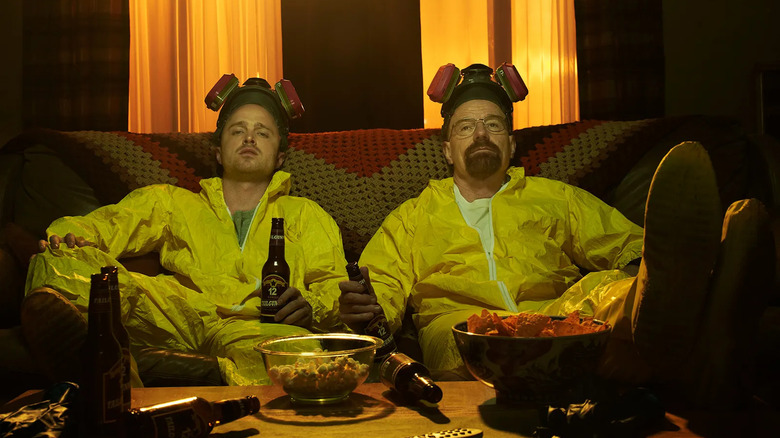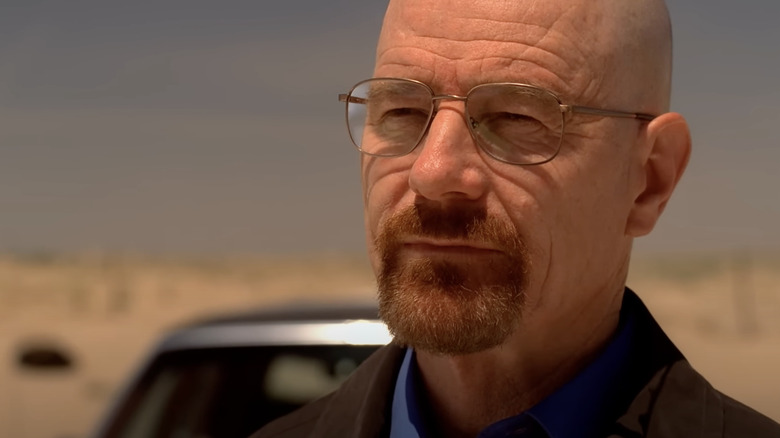Netflix Saved Breaking Bad From An Early Cancellation
Who doesn't love "Breaking Bad"? Some fans (including Stephen King) could say they liked it from the beginning, but even during its initial run, many came to it later. It's a little show that could, with the mythology of how it broke intertwined with the simultaneous rise of Netflix streaming.
"Breaking Bad" season 5 was a huge ratings smash, cashing out with 10+ million viewers for its series finale "Felina." During the first four seasons, "Breaking Bad" only cracked 2 million viewers once (the season 4 premiere "Box Cutter"). Those ratings tell a story; people streamed "Breaking Bad" on Netflix when they'd overlooked it on live TV, liked what they saw, and caught up for the last season. The "Box Cutter" ratings alone also suggest slowly accumulating higher interest. Vince Gilligan, creator of "Breaking Bad," has even thanked Netflix several times (including while talking to /Film) for boosting the series.
Netflix didn't just help "Breaking Bad," though; they may have saved it. The show's unspectacular ratings meant that, around season 3, AMC was considering canceling it. Production company Sony Pictures Television started looking for other networks to pick up the series if AMC backed out, but their savior ended up being Netflix. Sony licensed "Breaking Bad" to stream on Netflix and — aware the show was on thin ice — pushed up the timing so "Breaking Bad" would be added to the platform before the fourth season premiered, instead of afterwards as originally intended.
Even after that, the "Breaking Bad" writers were preparing the season 4 finale, "Face Off," as potentially the show's final curtain. But AMC made the right call, picking up "Breaking Bad" for its 16 episode final season.
Why Breaking Bad is remembered while most Netflix shows aren't
"We felt that it was a virtuous cycle, where we were introducing the show to new fans, who were then going and experiencing new episodes on AMC, and then when we would launch a new season, we would again see another wave of new folks coming," said Cindy Holland (former Netflix VP of original content) to the Hollywood Reporter.
Considering the role Netflix played in supporting "Breaking Bad," it's a pity then that Netflix has not heeded its own lessons. Since Netflix started producing and streaming its own shows in-house, they've become infamous for not giving shows a chance to pick up steam; unless you're "Stranger Things," a Netflix original almost never makes it past season 3.
It's not just early cancellations, though, that explain why no Netflix originals have reached the heights of "Breaking Bad." With no time slot ratings or advertisements like TV of old, the business model of Netflix is centered around people watching more and more. Hence the dreaded "season as a long movie" model so many Netflix shows follow.
"Breaking Bad" was never like that; each episode stands on its own. Its fully-staffed writers' room had all worked their way up the television ladder (Gilligan of course started on "The X-Files") and got all the time they needed to "break" episodes act-by-act. Before the 2023 WGA strike, many Netflix shows were put together by short-lived "mini-rooms" instead.
Netflix viewers binged "Breaking Bad" because each episode was so good that it made them want more, not because they needed to slog through eight uneventful hours to feel satisfied. Netflix saved "Breaking Bad," so now Netflix should look back to the show's lessons to save itself.
"Breaking Bad" is still streaming on Netflix.

